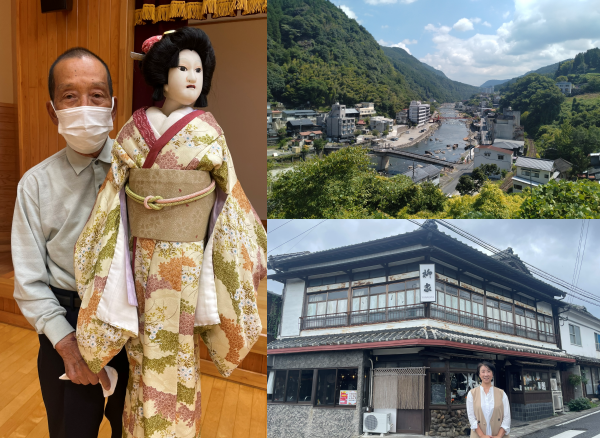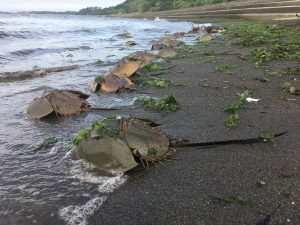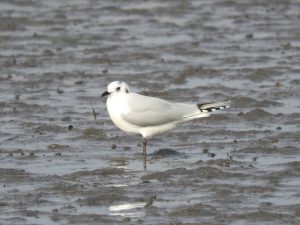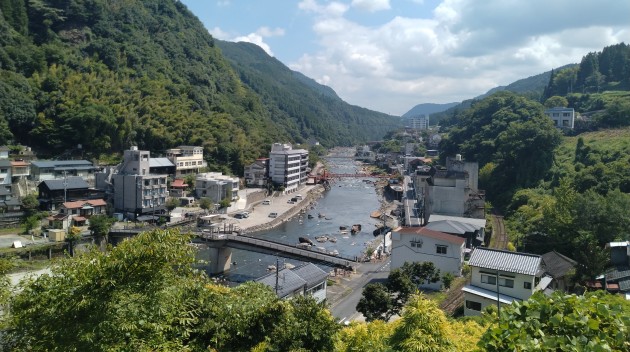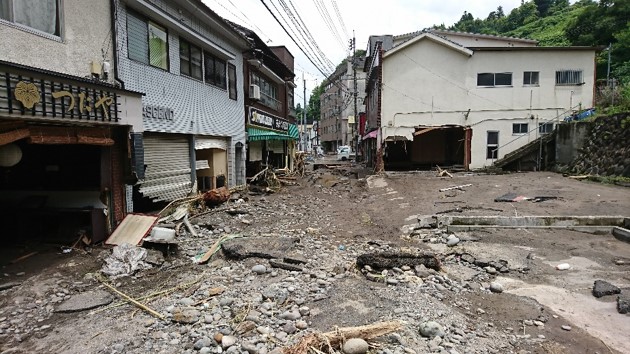実施日 : 2024年11月28日(木) - 29日(金)
Oita Press Tour
投稿日 : 2024年11月01日
<Application Closed>
If you are still interested in applying, please be aware that you will only be able to join if there are cancellations.
November 13, 2024
<Topics>
1. Oita, Coexisting with Nature— Impact of Climate Change/Building Communities Resilient to Natural Disasters
2. Protecting Oita History— Passing on Traditions and Historical Townscapes in a Time of a Declining Birthrate and Aging Population/Utilizing Vacant Homes to Revitalize Communities
<Tour Details>
Oita Prefecture has varied geography, including coastlines, plains, plateaus, rivers, and mountains, and is known as a treasure trove of nature and biological diversity. However, Oita Prefecture has also faced disasters such as heavy rains due to climate change. In recent years, large-scale disasters have been frequently occurring in the prefecture, such as the July 2020 heavy rains that caused six deaths, and building communities resilient to disasters has become an urgent issue. Rising ocean temperatures have also caused changes to the ecosystem and affected the fishing industry. Facing this situation, local citizens are carrying out conservation activities for rare species that live in tidal flats.
Like many other local governments in Japan, Oita Prefecture is facing serious issues with population decline and an aging society. The prefecture’s population peaked in 1955 at 1.28 million, and in October 2023 it dropped below 1.1 million for the first time since World War II. According to the National Institute of Population and Social Security Research, the population of Oita Prefecture in 2050 is expected to drop to three quarters of what it was 30 years earlier (to approximately 840,000). The ratio of people 65 years old or over in the general population was 34.2% as of October 2023, approximately 5 percentage points higher than the national average. In light of these circumstances, passing on Oita’s tradition and culture and maintaining local communities have become major issues.
This press tour will cover areas dealing with climate change, including the Nakatsu Tidal Flat with its unique ecosystem, and Amagase Onsen, recovering from heavy rains and aiming to create a community resilient to disasters. The tour will also cover efforts to pass on traditions and revive communities despite the population decline, covering children learning a local traditional performing art from seniors, and initiatives in the city of Kitsuki to revitalize the community by establishing places for locals to interact and making use of vacant homes.
Topic 1. Oita, Coexisting with Nature
—Impact of Climate Change/Building Communities Resilient to Natural Disasters
1. Nakatsu Tidal Flat (Nakatsu)
—The impact of climate change and conservation activities on a tidal flat, the “cradle of life”
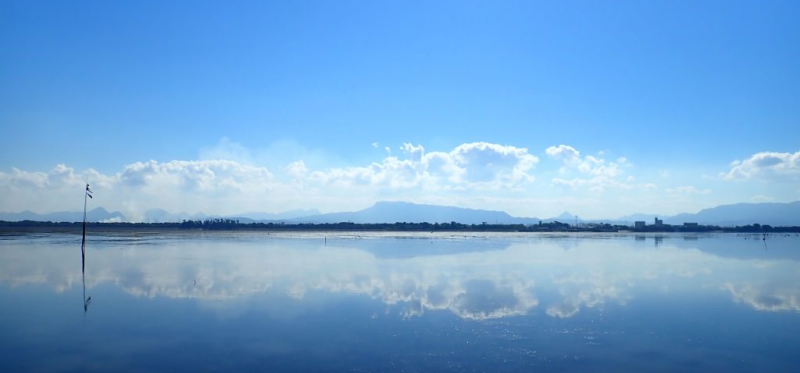
Photo courtesy of NPO Nakatsu Waterfront Conservation Association
Nakatsu Tidal Flat, located in northern Oita Prefecture, is the largest tidal flat in the Seto Inland Sea, extending approximately 10 kilometers from east to west and with an area of 1,347 hectares. Due to the nutrients brought there from rivers, tidal flats are known as “cradles of life” with high biodiversity, and the Nakatsu Tidal Flat is also home to numerous rare species such as the tri-spine horseshoe crab and small-scale whiting. According to studies by the NPO Nakatsu Waterfront Conservation Association, formed by local residents, nearly 30% of the species found in the Nakatsu Tidal Flat are rare species. It is also a destination for migratory birds, and Saunder’s gulls, a vulnerable species, also come to the Nakatsu Tidal Flat to spend the winter.
Photo courtesy of NPO Nakatsu Waterfront Conservation Association
In recent years, there have been signs of what to appear to be the impact of climate change in the Nakatsu Tidal Flat. With the rise in nearby ocean temperatures, the number of southern species has been increasing, and there have been reports of poor harvests of nori seaweed and oysters. The Nakatsu Waterfront Conservation Association, in order to have people understand the importance of the tidal flat and increase awareness of conservation activities, have been aiming to register the tidal flat as a Nationally Certified Sustainably Managed Natural Site*1 (OECM: Other effective area-based conservation measures) and as a Ramsar Convention*2 site.
*1: “Sites where biodiversity conservation is being promoted through private-sector initiatives,” certified by the Ministry of the Environment. Certifications began in FY2023.
*2: An international treaty for the conservation of wetlands of international importance as waterfowl habitats.

In addition to seeing the Nakatsu Tidal Flat, the tour will hear from Mr. Yoshimasa Ashikaga, director of the Nakatsu Waterfront Conservation Association, and Mr. Takumi Yamamori, the association’s secretary-general, about the changes occurring to the tidal flat and their conservation activities.
Photo (from left): Mr. Yoshimasa Ashikaga and Mr. Takumi Yamamori
2. Amagase Onsen (Hita)
—Recovery of a hot spring town damaged by heavy rains, and building a community resilient to disasters
Photos courtesy of Amagase Promotion Bureau
Amagase Onsen is an atmospheric hot spring town with hotels and ryokan (traditional Japanese inns) lining both sides of the Kusugawa River, with 1300 years of history. Heavy rains in July 2020 caused the river to flood, with eight of the 14 ryokan suffering major damage from flooding and sediment being deposited, as well as two of four bridges being washed out. The pedestrian suspension bridge that serves as a symbol for the area was restored in 2021, and the automobile bridge was also restored at last in July 2024, so there are hopes tourist numbers will recover.
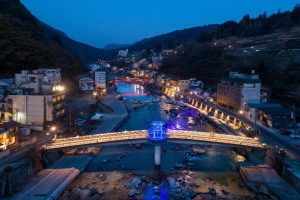
Photos courtesy of Amagase Promotion Bureau
The city of Hita established the Amagase Onsen Town Recovery Community Building Plan in 2023, focusing on building a community resistant to disaster and restoring vitality and tourism in the hot spring town. The plan involves carrying out reconstruction and building an attractive community, sharing ideas from people such as members of the Amagase Onsen Future Creation Project, composed mainly of young locals. Specific policies being considered include improving the Kusugawa River, creating new nighttime scenery with illumination, incorporating new tourism activities such as kayaking and SUP (stand-up paddleboarding), and installing lighting to warn if the river is at danger of flooding.
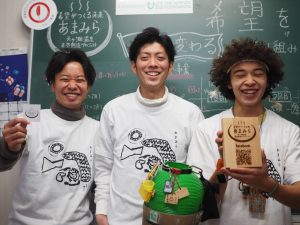
Photo courtesy of Amagase Onsen Future Creation Project
Staff from the Amagase Promotion Bureau will explain about the damage from the heavy rains and the recovery plan, and the tour will be guided around the hot spring town by Mr. Shinpei Kondo, representative of the local youth volunteer group Amagase Onsen Future Creation Project.
3. Hisatsune Forest Co., Ltd. (Nakatsu)
—Enabling sustainable forestry through aroma oil production
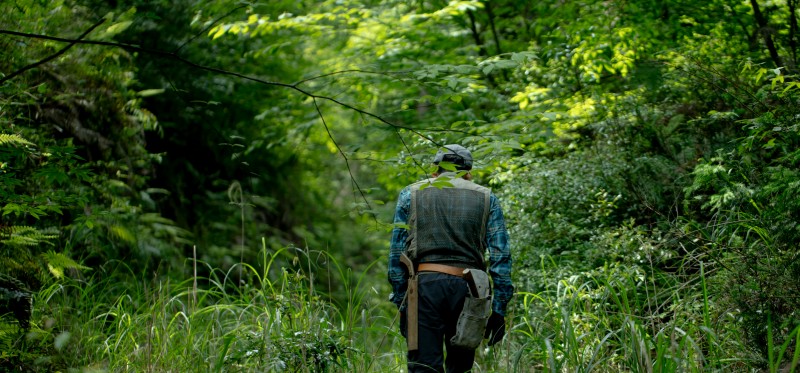
Photo courtesy of Hisatsune Forest Co., Ltd.
Two thirds of Japan’s land area is forested, making it one of the most heavily forested countries in the world, and 70% of Oita’s land area is forest. Forests not only allow for lumber production, they also protect from water disasters and landslides, conserve biodiversity, and absorb carbon dioxide, one of the causes behind global warming.
To maintain a healthy forest, it is important to carry out thinning periodically to adjust the density of trees in the forest. Maintenance such as thinning allows more sunlight to reach the ground level, nurturing richer soil and enabling the forest to function. Logging at the appropriate timing to make space for younger trees also helps increase the amount of carbon dioxide absorbed.
In recent years, with the rise in inexpensive imported lumber and a labor shortage, the number of forestry industry workers in Japan has been declining. According to a study by the Forestry Agency, the number of workers declined by around 70% over 40 years, from 146,000 workers in 1980 to 44,000 workers in 2020. As a result, proper management such as thinning is not being carried out, and some artificial forests have started to demonstrate risks of soil runoff and landslides due to rain.

Photos courtesy of Hisatsune Forest Co., Ltd.
In an effort to deal with these issues, Hisatsune Forest Co., Ltd. is using unused timber from forest thinning to produce aroma oils, with the goal of sustainable forestry. As well as creating a new revenue source with the aroma oil business and establishing the possibility of sustainable forestry, the company has also been contributing to stimulating farming villages by actively using local specialties such as kabosu (a citrus fruit) as ingredients. The president of Hisatsune Forest, Mr. Yuichiro Hisatsune, commented, “I hope that these aroma oils will be an opportunity for consumers to become interested in the importance of forests and the current state of the forestry industry.”
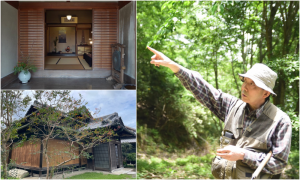
Photos courtesy of Hisatsune Forest Co., Ltd.
The tour will visit the Hisatsune Forest’s company building, which was built 100 years ago and is a nationally designated Tangible Cultural Property, and hear from company president Mr. Yuichiro Hisatsune about the current state of the forestry industry and his company’s aroma oil business. The tour will also be shown the interior of the company building and aroma oil being produced.
*The tour will not be visiting the forest.
Topic 2. Protecting Oita History
—Passing on Traditions and Historical Townscapes in a Time of a Declining Birthrate and Aging Population/Utilizing Vacant Homes to Revitalize Communities
4. Kitabaru Puppet Theater (Nakatsu)
—Passing on a traditional performing art with over 700 hundred years of history to elementary school students
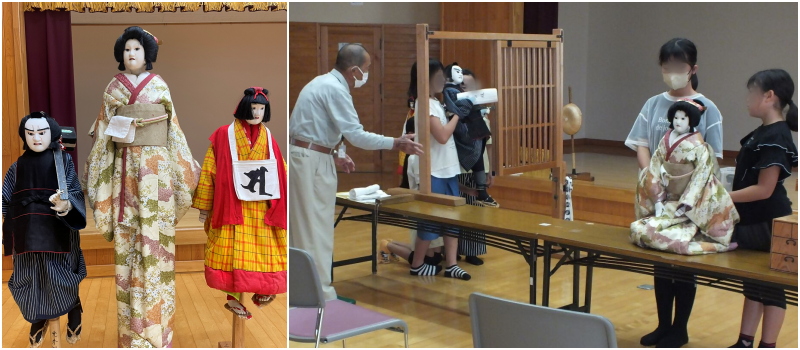
Photo (right) courtesy of Kitabaru Puppet Theater Preservation Association
Kitabaru Puppet Theater is a traditional performing art in the Kitabaru district of Nakatsu which has continued since the Kamakura period (1180–1336), and is a designated Intangible Folk Cultural Property of Oita Prefecture. This type of theater uniquely includes a single puppet being controlled by three people at once, accompanied by shamisen music and narration chanted by tayu.
With a dwindling number of performers becoming an issue due to the declining birthrate, the Kitabaru Puppet Theater Preservation Association has been working on passing on the tradition. The association teaches members of the local Miho Elementary School puppet theater club how to perform the puppet theater, training future performers. Each February, a ritual performance is held at a local shrine, and the children practice twice a month to prepare for this performance.

The tour will hear from Mr. Daisuke Sawamura (84 years old), an adviser for the Kitabaru Puppet Theater Preservation Association, about the history of Kitabaru Puppet Theater and his desire to pass it on. The tour will also be able to watch the students of Miho Elementary School practice Kitabaru Puppet Theater, and be able to interview Mr. Sawamura and the students.
5. Kitsuki City
—Utilizing vacant homes for local revitalization and new residents in a city with an aging population
As of 2020, people 65 years old or over made up 38.7% of the city of Kitsuki’s total population, above the average ratio for both the prefecture and Japan as a whole. In April 2024, the Population Strategy Council made up of private sector experts added Kitsuki to the list of “local governments likely to vanish” by 2050 should population decline continue. Vacant homes have also become an issue, with 24.0% of the homes in Kitsuki vacant as of 2018, significantly above the national average of 13.6%.
The tour will visit the following four locations in Kitsuki, learning about the attractions of the city, efforts by residents to revitalize the city, and a new resident running a hotel utilizing a previously vacant home.
5-1. Kitsuki Castle Town: How to protect a historical area retaining the scenery of the Edo period in light of an aging population
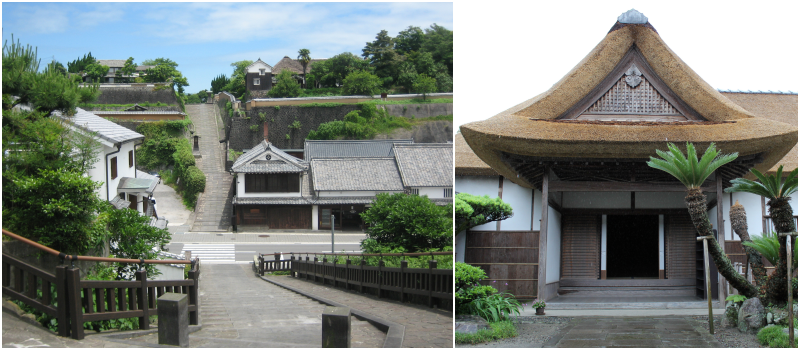
Photos courtesy of Kitsuki City Tourism Association
Kitsuki Castle Town is an area with high historical value, as it retains the cobblestone streets and samurai residences of the Edo period. Based around Kitsuki Castle, known as “the smallest castle in Japan,” samurai residences line the plateaus in the north and south, with merchants living in the lowland area between the plateaus, making for a unique townscape. This layout, reflecting the class system of the Edo period, has led to Kitsuki Castle Town also being called a “sandwich castle town.”
In recent years, due to factors such as building owners growing older, restoration work has not been carried out on aging buildings, and it has become more difficult to maintain the historical scenery. To pass on this unique townscape to the future, the municipal government has been implementing initiatives for historical conservation, such as providing subsidies for the preservation and repair of historical buildings.
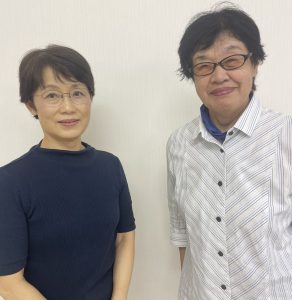
Led by a volunteer guide, the tour will see Kitsuki Castle Town and a samurai residence (the Ohara Residence) designated as a Tangible Cultural Property by Oita Prefecture.
Photo (from left): Volunteer guides Ms. Atsuko Onoue and Ms. Kumiko Ninose
5-2. Yanagiya: A restaurant that continued for 150 years reborn as a community center for the castle town. A 92 year old entrepreneur too!
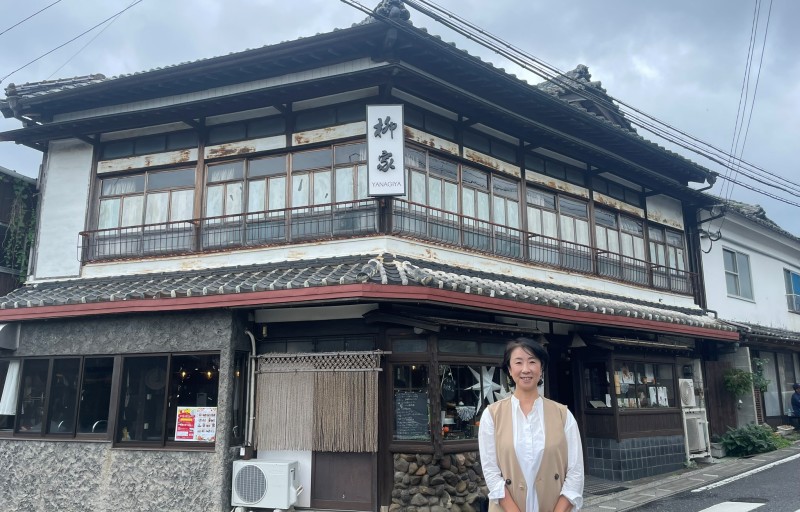
Ms. Noriko Ogura, owner of Yanagiya
Yanagiya, located in Kitsuki Castle Town, was a restaurant and cafeteria for 150 years, since the Meiji period. With the couple that ran it growing old, they considered closing the business and dismantling the building, but their daughter Ms. Noriko Ogura did not want to lose Yanagiya, a landmark in the town, and in 2020 reopened it as a shared space with a kitchen.
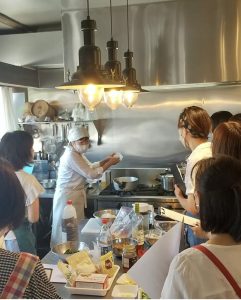
Photo courtesy of Yanagiya
Now a variety of activities take place at Yanagiya, such as foreign tourists sharing their country’s cooking with local residents and hopeful entrepreneurs doing test sales of their products. In the past three years, 20 people have started businesses thanks to Yanagiya, including some who have used vacant homes in the castle town for their businesses. In November 2024, a guesthouse is also planned to open using the second floor of the building, and new ideas for international exchange are being made, such as having local residents cook along with guests.
Inspired by Ms. Ogura, more local residents in the area around Yanagiya have been attempting to stimulate the community. A 92-year-old woman who lives near Yanagiya, along with her 62-year-old daughter, is planning to open a gelato shop in late November this year, which should help bring even more activity to the community.
The tour will hear from Ms. Noriko Ogura about initiatives for community revitalization based out of Yanagiya, and tour the building. The tour will also visit the gelato shop run by a 92 year old woman and her 62-year-old daughter and interview them.
5-3. Yamaga Bunko: A traditional house which became vacant, renovated into a hotel by new residents to the area
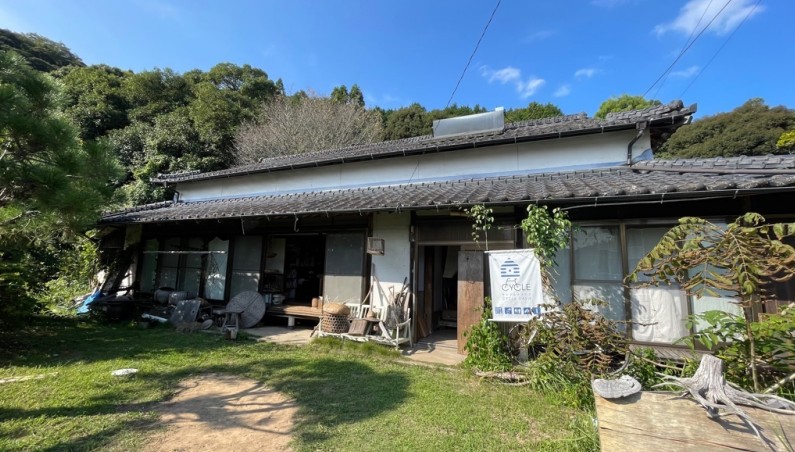
Photo courtesy of edit Oita
Yamaga Bunko, located in Yamagamachi, Kitsuki, allows guests to stay in a traditional Japanese house built 150 years ago in a farming village, and experience what living in the area is like. Business operator Mr. Fumikazu Makino, from Yamaguchi Prefecture, moved to the area in 2014, after becoming involved in agricultural promotion in Kitsuki as part of a government initiative to stimulate regional communities. At that time, he bought a traditional house that had been vacant for approximately 15 years, and restored it as his residence and a center for promoting the appeal of agriculture.
Now running Yamaga Bunko together with Ms. Yuri Kujirai from Saitama Prefecture, who moved to the area in 2019, they provide guests with meals made using local ingredients, promoting life in Yamagamachi and its food to guests.
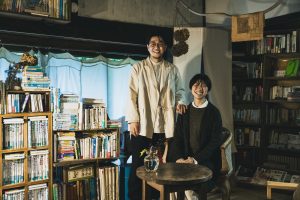
Photo courtesy of edit Oita / Reference article (Japanese) https://edit.pref.oita.jp/series/meeting/4798/
The tour will hear from Mr. Fumikazu Makino and Ms. Yuri Kujirai about Yamaga Bunko and their vision for its future, and tour the facility.
5-4. Nakano Shuzo: The only remaining sake brewery in the castle town, making sake with “tradition and innovation”
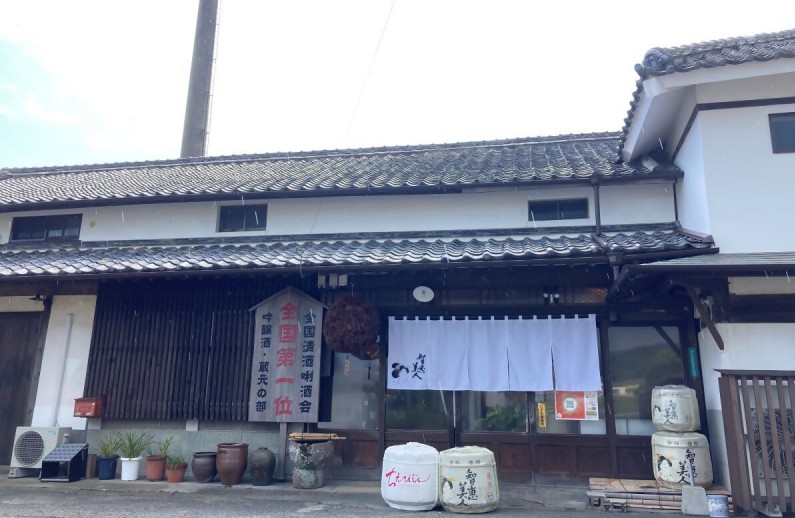
Photo courtesy of Nakano Shuzo Co., Ltd.
There used to be many sake breweries in Kitsuki Castle Town, but they slowly vanished one by one, and in 2024 the only one remaining in business is Nakano Shuzo, established 150 years ago. While protecting traditions as the only remaining sake brewery in the castle town, in order to pass on their sake making to the next generation Nakano Shuzo has been actively expanding its overseas sales, exporting their sake to 15 countries such as the UK and Brazil. The brewery is also active in promoting the local community, making sake using locally-produced ingredients and suggesting pairings with local foods.

Photo courtesy of Nakano Shuzo Co., Ltd.
Nakano Shuzo is also working to reduce food loss when making sake. Part of the process of making sake involves removing the outer layer of the rice grains, and it is generally said that the more the rice is polished, the more fragrant, delicious, and high-grade the sake is made. High-grade Daiginjo sake polishes away at least 50% of the rice, but Nakano Shuzo has continued experimenting with ways to make flavorful sake even with less polishing of the rice. As a result, they created Chiebijin Junmaishu, polishing the rice by only 30%, which has been gaining recognition overseas, such as winning the Prix du Président at the 2018 Kura Master sake competition held in Paris.
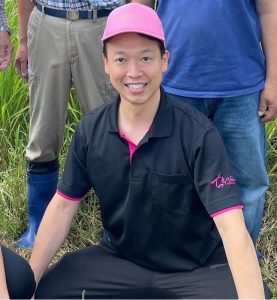
Photo courtesy of Nakano Shuzo Co., Ltd.
The tour will hear from Mr. Atsuyuki Nakano, who took over Nakano Shuzo in 2015 while in his 30s, about the brewery’s sake, as well as seeing part of the brewery. Sake tasting will also be available for those who are interested.
【Tour Itinerary】
*Application Deadline: November 13, at noon
1. Dates:
Thursday, November 28 to Friday, November 29, 2024
<Day 1: Thursday, November 28>
07:35 - 09:20 Haneda Airport → Kitakyushu Airport
10:45 - 12:25 Nakatsu Tidal Flat
12:40 - 13:25 Lunch
13:35 - 15:30 Hisatsune Forest
15:50 - 17:20 Kitabaru Puppet Theater
18:30 Arrive at hotel (Hita)
<Day 2: Friday, November 29>
07:45 Leave Hotel
08:30 - 10:15 Amagase Onsen
11:35 - 12:35 Yamaga Bunko
12:55 - 13:40 Lunch
13:45 - 14:20 Kitsuki Castle Town
14:40 - 16:00 Yanagiya
16:10 - 17:30 Nakano Shuzo
19:45 - 21:20 Oita Airport → Haneda Airport
3. Qualification: Bearer of the Ministry of Foreign Affairs of Japan Press Registration Card (in principle)
*Participants will be determined by the tour sponsor.
4. Cost: 15,000 yen per person, including transportation, accommodation (breakfast included), and lunches (for both days)
*Information on payment and cancellation fee will be provided to participants.
*Participants will be required to pay their own transportation costs to the meeting place before the tour, and after the tour ends.
5. Participants: Limited to 10 participants.
(Only one reporter or one photographer from each company, but two participants from each TV team will be acceptable.)
6.Please be sure to confirm and agree to the following before applying
6-1. Basic Information
(1) This tour is organized by Oita Prefecture and run by the FPCJ.
(2) The schedule is subject to change without notice.
(3) This tour will require participants to bear a part of the cost but is not a profit-making venture.
(4) Oita Prefecture and the FPCJ take no responsibility for any accidents, injuries, illness, or other problems which occur during the tour.
(5) There may be some restrictions on photographing and filming at the tour sites. Please follow the instructions of the staff in charge.
(6) This press tour is intended to provide opportunities for news coverage. We request that all participants send a copy of the content of their coverage (article, video, or audio in the case of radio) to Oita Prefecture through the FPCJ after their reports are published or aired. When your report is in a language other than English or Japanese, we also ask you to provide a summary in English or Japanese. By submitting your application, we assume that you have agreed to these conditions.
6-2.Handling of Personal Information
When applying for the tour, you agree to the below.
*Regarding the handling of personal information, the press tour sponsors and operators will respect Japan’s Act on the Protection of Personal Information and all other laws and guidelines on the protection of personal information, and handle personal information appropriately.
(1)The tour operators will, when there is a need to do so for the press tour, provide the personal information provided when applying (organization name, personal name, etc.) to other parties in the following cases:
-To arrange travel or insurance through travel agencies (Information provided to: Travel agencies, accommodation operators, transportation operators, insurance companies)
-To ensure smooth operations during the tour (Information provided to: Interpreters, stops on the tour, interviewees)
(2) The tour operators, to ensure smooth operation of the tour, will share the personal names and organization names of applicants with the tour sponsors.
6-3.Recordings by Press Tour Sponsors or Operators During the Tour
When applying for the tour, you agree to the below.
(1) For the record-keeping purposes, the tour operators may film or photograph the tour while it is happening. The copyright holders for these photos or videos will be the tour sponsors.
(2) Photos, videos, or articles of the press tour may be uploaded to websites or social media accounts operated by the sponsors or operators.
(3) The likeness or voice of participants may appear in the abovementioned photos or videos, but you agree to their use by the sponsors or operators.
7. FPCJ Contact: Shimizu(Ms.), Yoshida (Ms.) , Mizutani (Ms.)
Media Relations Division
(Tel: 03-3501-3405, E-mail: ma@fpcjpn.or.jp)
◆When applying for the tour, you agree to the following conditions◆
- Press tours have participants from multiple media organizations, and interviews, filming, and photographing are generally carried out jointly. There is no guarantee that you will be able to perform individual interviews or take individual videos at any of the stops on the tour.
- You must follow the instructions of the tour sponsor and operators regarding the tour schedule, timing, and restrictions on taking videos or photos. If you refuse to follow instructions, you will no longer be allowed to participate in the press tour from that point on.

